When I first heard someone mention oxygen absorbers in casual conversation, I thought “What are those, again?” But as soon as I saw a picture of them, I knew exactly what they were.
You’ve most likely seen these little packets in packages of food that you purchase at the grocery store. They’re usually white, but can come in other colors as well.
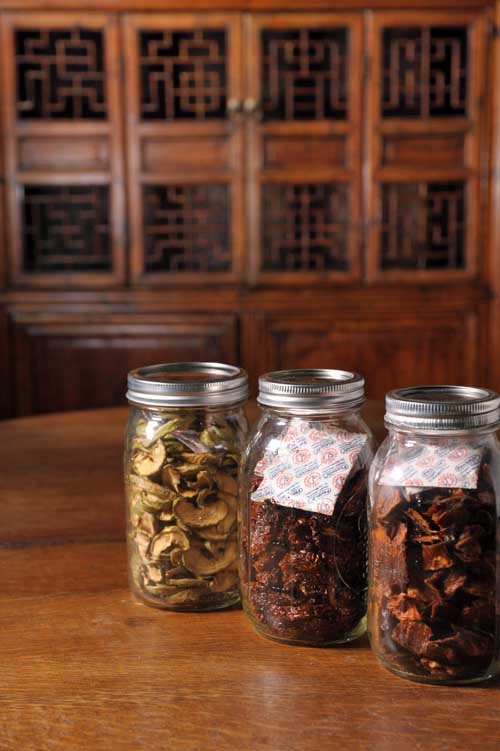
The reason I first became interested in these was because they came up in my research, when I was exploring ways to preserve food that I had dried with my food dehydrator. I wanted my food to last throughout the year and stay crisp.
Once I started reading about them, I knew these were exactly what I was looking for.
Today, I want to share what I’ve learned with you, regarding how they work, and some ways you can start using them in your own kitchen with your home dehydrating pursuits.
The best part is, they’re easy to use (and super inexpensive, too)!
So, What Are They?
These little parcels are filled with iron powder. The iron absorbs 99% of the oxygen that’s present when placed in a sealed environment, like a jar or bag. The remaining atmospheric gases are completely inert and don’t lead to food degradation through the oxidization process.
When the packets are removed from their sealed container, they immediately start absorbing O2, which reacts to with the iron powder, forming iron oxide through a catalyst.
If the packets are placed in a sealed environment such as a canning jar or bag, almost all of the oxygen will be removed (if you’ve used the correct quantity of packets), and the chemical reaction will stop.
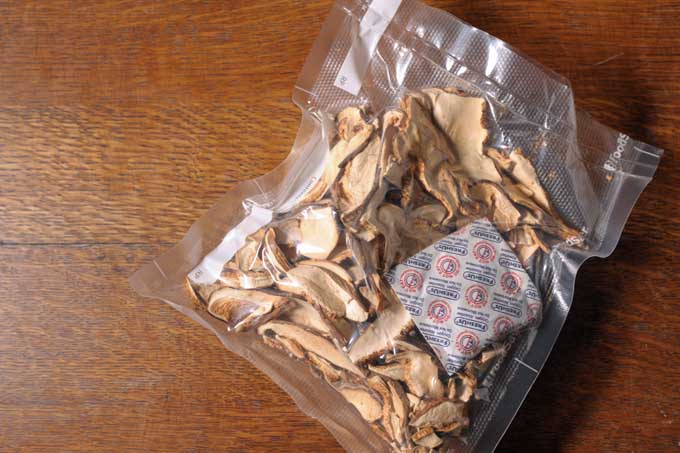
The remaining atmospheric gases – mostly nitrogen – is ideal for long-term storage. This keeps food from going rancid, and also keeping bugs and insects out.
The moisture and air are absorbed, but the powder inside the packet is kept secure and separate from edible items. This means you can place the packets directly on your food in the appropriate container, without having to worry about these items becoming contaminated.
When oxygen absorbers are in use, they heat up – if you were to remove one that’s activated from your jar or container of dry goods while it’s doing it’s thing, it would actually be warm to the touch. They work on the same chemical reaction process as disposable hand warmers.
They generally take up to four hours to remove the O2 from a sealed bag or other container.
Why Use Them?
There are a few reasons why you might want to use these.
The main reason is that, if you’re interested in dehydrating your food at home, they will increase the shelf life of these products. Or, if you buy any food that’s already been dried, they can be used to further extend the life of these items as well.
One thing I really like is that they preserve food without using any artificial additives or chemicals to make the food last – which is the route a lot of pre-packaged food companies take.
They also help to keep pathogens from growing in your food. Many unwanted organisms and various types of mold cannot survive in an environment that is all nitrogen.
If you keep the oxygen out, your food will be safe, and it will keep for the long haul. If not, it runs the risk of spoiling.
An important note:
O2 absorbers should never be used to preserve products that contain more than 10 percent moisture, as this type of packaging may increase the risk of botulism poisoning.
Products with a high oil content (like nuts, seeds, and whole grains) will have a shorter shelf life than other products. If you are uncertain as to which specific items may be preserved with these products, I encourage you to do further research.
Now, there’s no denying that these are easy to use. But to make sure they do their job effectively, there are a few things you need to be aware of beforehand:
Common Mistakes
When using these, many people go wrong by opening them up too soon, and failing to get them into a sealed container quickly enough. The problem involved here is that they start working immediately.
If you open them before your food is ready to store, the packets will start absorbing the air, and won’t have much iron left to preserve your food.
Another problem you might face when preserving your food with these packets is trying to use ones that no longer work.
How can you tell?
A lot of companies will include a little pill in the container. If it’s pink, then they’re still good. If it’s blue or purple, they’re no longer active, and should be tossed.
It’s important to keep in mind that some companies claim the pill will still be pink if only one packet in the entire package is good. In other words, in a package of 100, 99 could be bad if just one is still good, and the pill will still be pink.
That being said, another way to check is to simply hold the packet in your hand. If you can feel the loose powder, that’s a good sign that it’s ready to use. If it’s hard or solid, that usually means the contents have been used up already, and you should dispose of it.
Keeping that in mind, be diligent when storing extra absorbers – the better you are able to preserve them, the less frequently you will have to buy more to replace ones that have expired. This is better for your wallet, and the environment.
Using Oxygen Absorbers
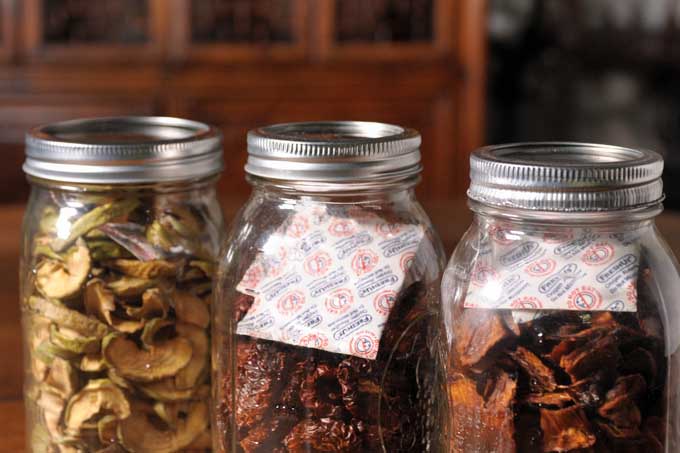
1. Determine exactly how many packets you’ll need to place in with your food.
2. Prepare your food by placing it in the container you wish to store it in.
3. Have a container ready to store the remaining packets in. Once you open the bag, you’ll need to place the leftovers in a container that is properly sealed right away.
You can always reseal the bag you bought them in with a hot iron. However, you won’t be able to do that more than a few times, as it will become hard to open and then reseal if the bag gets too small.
4. Be prepared to seal your container as soon as you place the packet(s) inside.
5. Store in a dark, dry place.
Recommended Containers for Storing Your Food
When it comes to containers, the best for this job are Mylar bags, Mason jars, and large buckets. All three of these seal very well, making them perfect options.
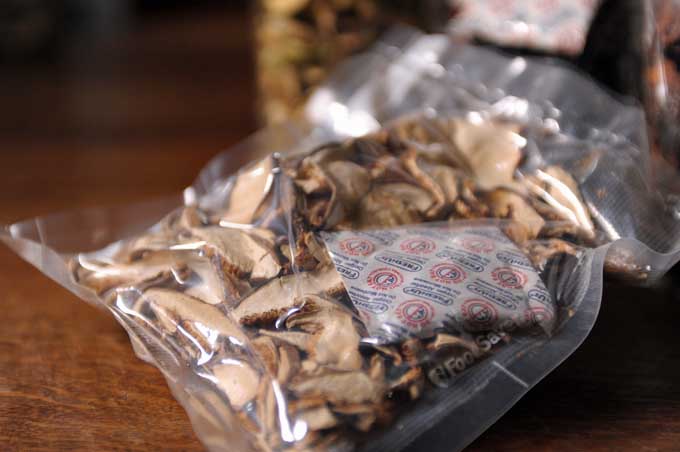
The amount of food you are preserving will help you to figure out what type of bag you’ll want to use. If you are preserving a small amount, a Mason jar should do the trick.
If this is the case, simply place the food in the jar with the packet(s), then use the ring and lid to seal the can.
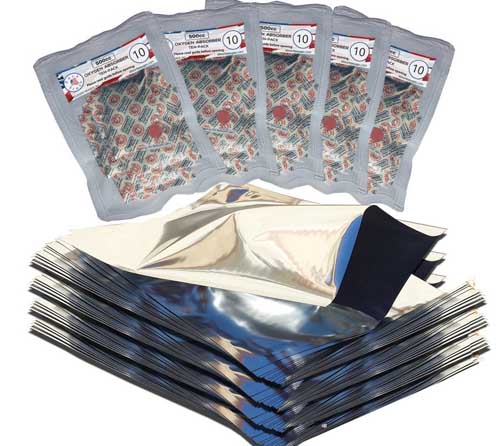
Gallon Mylar Bags with 500cc Oxygen Absorbers available on Amazon
The absorber will do the sealing part, by removing the air. You will hear a pop when it’s done, and you shouldn’t be able to make the top move when you press down on the lid.
If you’re storing a greater quantity of food, a Mylar bag or a food-safe bucket might make more sense.
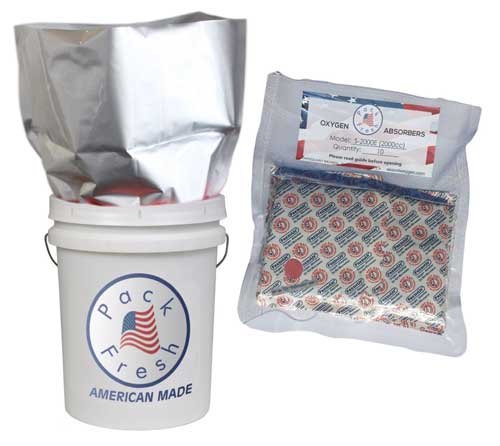
(10) 5 Gallon Genuine Mylar Bags (Made in USA) with 2000cc Oxygen Absorbers
Place the food in the bag, leaving some room at the top. Fold the bag closed, and then seal it.
To create a seal, you’ll need to run something hot over it to completely close it – a clothing iron or an electric hair straightener both work well.
From there, if you wish, you can place the bag in a bucket with a lid for extra protection.
Vacuum sealers seem to work okay as well. Personally, I prefer the Mylar bags, but many people swear by these.
Simply add the recommended number of packets, and then use the sealer to close the bag.
How Many Packets Will You Need?
In order to know how many packets are needed, you’ll have to figure out how much oxygen your container holds. To do this, you need to determine the volume.
In addition to the volume of the container, you’ll also need to consider the type of food that’s being packed.
Finally, you will need to figure out the volume of the “void space” (the empty space between the food items) and the “head space” (all of the space in the container that’s not filled).
To help you get started, here’s a general formula to find the oxygen absorption required, in cubic centimeters:
Container Volume – Food Volume = Residual Air Volume
1 gram (g) = 1 cubic centimeter (cc)
It’s hard to estimate void space and head space, so I recommend adding a few extra cubic centimeters. It’s better to be on the conservative side where food safety is concerned.
Usually Sold in the Following Sizes:
Now, if you’re not good with math, here are some popular storage container sizes and the size packet you will need:
- 1 pint up to 1 quart Mason jar = 50cc
- 1 gallon Mylar bag = 300cc
- 5 gallon bucket with low air volume (think rice and flour) = 1000cc
- 5 gallon bucket with high air volume (think pasta) = 2000cc
Depending on what size you choose to purchase, you can always combine packets to reach the total quantity of cubic centimeters of volume that you’re working with.
Recommended Foods
When it comes to using this product, consider the many dried foods you commonly store and that you don’t want to go bad. These may include staple items such as:
- Beans
- Legumes
- Nuts
- Seeds (unless you plan to sprout them)
- Dried Fruit
- Dried Vegetables
- Grains
- Popcorn Kernels
- Oatmeal
- Flours
- Cereals
- Pasta
- Crackers
There are just two things you’ll want to completely avoid adding these packets to: sugar and salt.
Neither one needs to be preserved. If you think about it, salt and sugar are often the substances that are actually used to do the food preservation – so extra preservatives aren’t needed!
If you use these packets in a container filled with sugar or salt, you can expect them to turn rock solid, becoming totally useless to you.
Not to Be Confused with Silica Packets
It’s easy to mistake the product that I’m talking about with silica gel, which is made of silicon dioxide.
You’ve most likely seen silica packets in with your new shoes, purses, or electronic products like cameras.
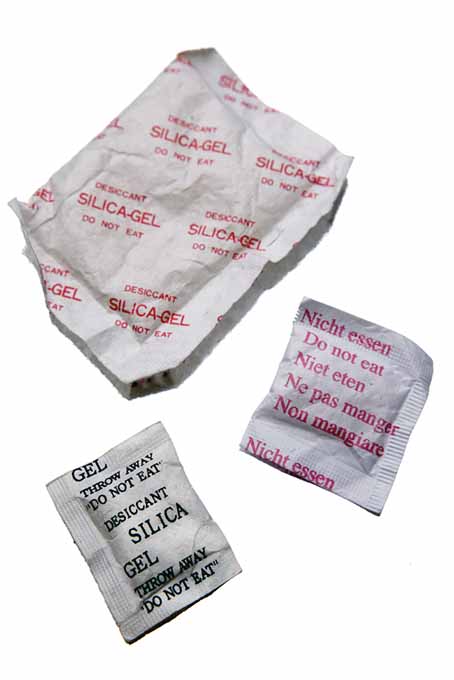
Silica packets are desiccants, meaning they help to remove moisture and keep things from molding.
According to All Things Emergency Prepared, it’s important to be sure that desiccants are properly packaged before using them with food, because they are not edible. If the desiccant accidentally opens and mixes with your food, you must throw it all away.
If you’ll be using oxygen absorbers and dessicants together, it’s best to place the silica packets on the bottom of your chosen storage container, and the oxygen absorbers on top.
Additional Food Storage Tips
Check out the following tips, to help get you started on the road to successful food storage using oxygen absorber packets.
Consider Temperature
When storing food, it’s important to keep the temperature at or below room temperature. I suggest keeping things at 40-50°F, if you can manage it.
However, typical room temperature is usually much warmer. Storing dry goods at temperatures below 75°F and away from direct sunlight is usually fine.
You’ll want to avoid temps over 90°F entirely, as this kind of heat will speed up the arrival of that expiration date.
Watch for Moisture
If you store your food in a cold or moist environment, condensation is likely. And this will cause your food to spoil at a quicker rate. That being said, you want to store it in as dry of a location as possible.
Foods high in moisture or oil, even if they seem “dry,” are not ideal candidates for preservation with oxygen absorbers. Storing these foods in this type of packaging increases the risk of botulism.
According to Carolyn Washington, FCS agent and associate professor in the food and nutrition department at the Utah State University Cooperative Extension, some foods are not actually sensitive to oxygen, so there is no use in utilizing O2 absorbers to store them.
These include: beans, peas, corn, and wheat.
Look Out for Light
Sunshine is the number one culprit here. This is why I don’t recommend storing your product on a counter, or out in the open.
A cabinet that is dark and dry is going to be your best bet. The basement is fine as long as it’s not too cold, and if you keep your food up off the ground.

300cc oxygen absorbers available on Amazon
If you follow these tips in combination with using the right quantity of active packets, your food should keep very well.
I hope this post has cleared up any questions you may have. Get out there and give this product a try, and use what you’ve learned here to improve your food storing efforts. Let me know how it goes in the comments!
Photos of absorbers in use by Mike Quinn, © Ask the Experts, LLC. ALL RIGHTS RESERVED. Product photos are owned by their respective manufacturers and/or distributors. See our TOS for more details.
Foodal and Ask the Experts, LLC are not liable for any use or misuse of the products described within this article; do your own due diligence to learn the appropriate guidelines for storing food. Observe guidance and best practice recommendations issued by the U.S. Food and Drug Administration (or your country’s equivalent) and state and local organizations (such as university extensions), and take all necessary precautions to safely store your perishables.
About Sarah Hagstrom
Sarah is a health food advocate and loves to spend her time whipping up something healthy and delicious in the kitchen and then sharing either on Foodal or on her own blog "The Seasonal Diet" (www.theseasonaldiet.com). She lives in Sunny San Diego with her husband, where they enjoy running on the beach and weekend adventures.



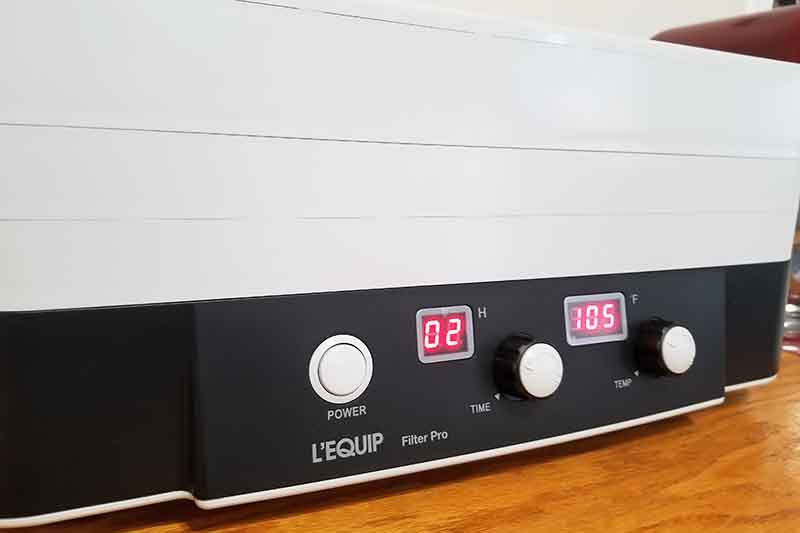


I have always wondered what these little packets contain. I have just known not to eat them, which is funny to think about until I actually had to make sure a kid at work did not eat one, because they are not good for you. Anytime that you can have something that can preserve my food and save me some money though, I am all for that.
No eating these and, yes keep them away from the kiddos! I hope you’ll give them a try, they will for sure keep your food fresher longer.
I’M NEW TO THIS AS I AM GREAT GRANNY THE CANNER. LOL. I CAN EVERYTHING I CAN GET MY HANDS ON. NOW FOR MY QUESTION, CAN I USE THESE LITTLE PACKETS FOR MY LARGE QUANTITY OF FLAX SEED IN 1/2 GALLON JARS?
Thanks for your message! Yes, oxygen absorbers will help to increase the shelf life of flaxseed.
Wow, I never realized that that is what those packets were for. Thanks for the info! I personally use vacuum sealers, which is great for items with higher moisture like that you stated, like meats and stuff. However, I might consider using these packets for rice. I use vacuum bags for my white rice, and the little grains always make a little puncture that breaks the plastic and causes the bag to lose its seal. Botulism is a big worry for me; it’s one of the reasons why I never got into canning food, despite it looking useful and fun. This looks like a great way to securely store drier foods, though. Thanks!
Glad to help! Let me know if you give them a try, I think you’ll be surprised by how well they work.
I use a lot of these for my long term food storage. I tend to buy the larger oxygen absorbers as I lay in a lot of rice/pasta and other dried goods. My preferred method is to keep the goods in their original packaging and then make a few pin pricks in it, pop them in the mylar bags with the oxygen absorbers and then heat seal the mylar. I keep the food in its original packaging to add an additional layer of protection, which is particularly important for things like pasta shapes that can be quite harsh around the edges. I have in the past stored unused oxygen absorbers in a couple of ziplock baggies, with mixed results, so now I use a screw top jar.
Hey ukfoodiegirl, that is a great idea. Thanks for sharing.
Thank you so much for the tip leaving food in the original package.
This is a very interesting article!
I have never heard of these and I don’t remember seeing one in anything I’ve bought.
I do know, on the other hand, the silica gels.
Thank you for sharing with us, these will be quite useful in the autumn when we start preserving beans and stuff. Now I have to see if I can find them in my country 🙂
Thanks for the article. I’d never heard of these, only the silica packs for desiccating,and I did wonder how canning removed the oxygen to keep things fresh. I don’t do much canning at the moment but I might have to pick up a few packs to try out for preserving peas and mini-beans.
Looking at the image, it looks like the packs come in sections. How many are there in each section, and can they be resealed in a different air-tight bag to keep them fresh if you don’t use them all? I’m not sure I’m up to the iron trick you mention!
Thank you so much for this post! I’ve seen people talk about these in videos and life hack sites before, but never about using them for food! I put one in my makeup bag and have some in my first aid kit to make sure if there’s spills then things stay dry, but I never thought of using them for food. Nor did I know that you can seal a bag with a hot iron, although it’s pretty obvious. So I learned two things here today and that’s awesome. I’ll definitely be using these more often now.
I didn’t know that oxygen absosrbers existed until now. I always assumed that vacuum sealers were to only way to preserve it well. When it comes to storing the unused absorbers what’s a good place to put them? Is a mason jar a good idea or should I stick to ziploc bags?
This article is right on time! I just purchased a food dehydrator and this will help immensely!
That’s awesome, Aarone. Enjoy the dehydrating- and let us know what you make!
I always had confusion about when and what to use oxygen abosrbers and silica gel. I learned the diffierence by working with sorbead India that oxygen absorbers are limited to maintain a certain level of humidity whereas silica gel is used to reduce the humidity.
Do you think this will work to keep popped popcorn crunchy in a sealed bag?
Though it’s a great idea to store unpopped kernels with oxygen absorbers to improve their shelf life, most sources that I’ve checked say dessicant packets will actually remove too much moisture from popped popcorn, resulting in a stale texture. This isn’t something that I’ve tried personally, but you might like to try storing it in the freezer – many people claim this works!
I’ve always used a big chunk of onion to keep my cut avocados from going off in a container in the fridge, but the onion doesn’t last long. Would an oxygen absorber be a better option? If so, what cc would you recommend for one avocado in an appropriate sized container?
I’ve never heard of this onion trick- thanks for sharing, Danni! This seems to be effective because of the sulfur the onions contain.
Dessicant packets are used to absorb moisture and oxygen, to make shelf-stable foods like dried beans and grains last longer. They should never be used to package fresh foods like avocado that contain more than 10 percent moisture.
Instead, try covering the cut surface of the avocado tightly and completely with a layer of plastic wrap – oxidation will occur more slowly if the cut portions of the fruit are not exposed to air like they would be in an open container. You can read more about storing avocados here.
Thank you for all the info. I’m still confused though…what is the best for my dried food. Up to now I use the silica gel. I use pint and quart containers..the canning types. Also ziplock bags.
Should I start using oxygen abs? Want them safe long term.
Thank you
These products work differently, but oxygen absorbers are generally recommended for storing dry shelf-stable foods. Food safe silica dessicant packets absorb moisture while iron oxide packets like those described in this article absorb oxygen. These generally should not be used together.
Overall, oxygen absorbers are meant to be used with dry food products that have a moisture content of 10% or less. Silica dessicant packets can be used to absorb moisture for safe storage of foods that have a higher moisture content- you may have seen thin silica “blankets” lining the bottom of a package of meat, for example – and these can be used to keep foods and other products dry even in damp or humid conditions. Silica should not be used with powdered products like salt or flour, since they will absorb all of the moisture and you’ll be left with a hard brick of whatever you’ve put in the container to store.
This was a really helpful and informative article to start with but has been considerably added to by the Q&A over the last few years. I’ve just obtained a desiccator and the research and experience here will help me avoid the pitfalls of preparing and storing dried food. I particularly appreciate the several warnings about botulism as one of my first professional tasks (a long time ago) involved helping to head-off the outbreak of botulism from canned salmon. Being frequently fatal it is not something to take lightly.
I’ve posted a link to your article on my Pinterest page – excellent work.
My question is: I was given quart jars filled with cake mixes, pancake mixes, muffin mixes, brownie mixes dry cereal, cream of wheat in their packages, oatmeal in their packages too, & etc. They have oxgen absorbers in them & were sealed with a food saver machine.
Are these safe to eat? I’m confused.
Thank You
Can I use 500cc’s in my quart containers if the recommendation is less than that?
I own a small gourmet popcorn shop and we are struggling with humidity in MN. We currently heat seal a thicker mil bag but continue to get a “soggy” texture. All popcorn goes in the bag cooled to avoid any steam build up. Do you have any suggestions? We were hoping to use the OxyAbsorbers to combat the humidity. All popcorn contains coconut oil and our caramel/kettle popcorns contain sugar, oil, salt, etc.
Thank you for the great article and any advice you can offer!
Popped flavored popcorn can be tricky to store, particularly during periods of humid weather. Could the size of the bags you’re using also be an issue? Dessicant packets may be a better option for you than oxygen absorbers, since flavored popcorn is going to contain some amount of moisture no matter what you do. But be sure to add a label to the packaging to warn your customers if any type of oxygen or moisture-combating packet is included in the bag – overzealous eaters or those enjoying a film in the dark who are unaware may accidentally toss one of these in their mouth, and get a nasty surprise. Switching to mylar bags or simply bags that are smaller may help as well, with the addition of oxygen absorbers. Good luck with the popcorn!
What if my dog ate one
Vomiting is a common reaction, and iron poisoning can occur in very small dogs. We recommend calling your veterinarian for advice.
Can oxygen absorbers be used in storing prepackaged dehydrated soups that are in a plastic container? What about prepackaged lentils stored in a plastic container?
This depends on part on the ingredients that are in these soups. Oxygen absorbers can be used with things like dried vegetables and beans, for example, while something like a dried powder that’s high in fat (such as cheese) would be transformed into a hard mass, or it could potentially spoil more quickly than the other ingredients.
These are an excellent option for storing dried lentils.
Products should be removed from plastic bags. Some people like to use mylar for storage with oxygen absorbers, and glass jars or vacuum-sealed bags are excellent options as well. Plastic isn’t often a top pick because some containers won’t make an airtight seal.
Thanks. Just what I needed. To counter inflation I’m starting to store some foods. I just put up 25 pint jars of cream of wheat. 8 of the lids did not seal. Advice appreciated.
Good luck with the food storage, Jack! Overall, anything pressure canned in a jar with a lid that has not sealed must be refrigerated and used right away- containers with failed seals are not suitable for long-term shelf storage. However, this type of canning is only suitable for wet ingredients with an appropriate level of acidity.
When using oxygen absorbers, Mylar bags are the preferred packaging material rather than jars. Dry ingredients like cream of wheat cereal can’t be stored by pressure canning, so canning lids are not your best option in this case. Lids on other types of containers may be air-tight, but they will not seal like they would if they were processed in boiling water.
This is a very informative blog.
You made the following statement:
“O2 absorbers should never be used to preserve products that contain more than 10 percent moisture, as this type of packaging may increase the risk of botulism poisoning.
Products with a high oil content (like nuts, seeds, and whole grains) will have a shorter shelf life than other products. If you are uncertain as to which specific items may be preserved with these products, I encourage you to do further research.”
From what source did you get this information from?
See the cited reference from Carolyn Washburn at the Utah State University Cooperative Extension linked above. Additional information can be found here and here.
we are taking mac & cheese out of the box and putting it in a canning jar, then using this new Item we found that fits over the seal and jar then using a pump or your , what the kids call, the suck and seal machine”, to remove the air out of the jar and sealing the jar. it works well. there are just noodles and a package of powdered cheese in each jar.
We didn’t our first batch without any, and have been wondering if we should have. I just read not to use the oxygen absorbers in the jars with powdered cheese. If we do, should we put the cheese packets in a separate container, and how do we keep them from spoiling?
This is our first year of putting up dry foods.
Unopened and properly stored, packaged powdered cheese in a foil and paper packet should last for two years. If repackaged in airtight Mylar bags or containers with oxygen absorbers and kept cool, it can potentially last longer. But placing the packets themselves in a container with oxygen absorbers won’t have much of an effect, if any.
Hey there, I frequently read your site since you truly do offer helpful health information.
Thank you
Nice Information
I am wondering if there is any advantage of vacuum sealing and then putting the vacuum sealed packages of dry food into a mylar bag with oxygen absorber. Is there any advantage or disadvantage for long term storage. My thought was to have smaller packages of mixed items flour-beans-crackers-rice-pancake mix-dried powdered eggs etc into one large mylar bag.
Vacuum sealing in Mylar bags is probably your best option. There isn’t really any additional advantage to double bagging, and this may introduce unwanted moisture.
What is the proper way to store dried minced onion from the store? Mylar bags with or without an oxygen absorber?
Yes, you can store dehydrated onions in sealed Mylar bags with an oxygen absorber. I’ve also heard of successful long-term storage in vacuum-sealed jars without an oxygen absorber, so you have options!
So do I put these packets in my elbow noodles and rice? They are in vacuum sealed jars.
Oxygen absorbers are used to create a vacuum seal in jars and they’re an excellent option for extending the shelf life of rice and dry pasta.
Hello,
Can I use Oxygen absorbers in my snack food that has oil tempering.
Can you clarify for us, please? Do you mean snack food that has been deep-fried?
If that is the case, we don’t recommend using oxygen absorbers for those types of products. As we discussed in the article, when it comes to using oxygen absorbers, this works the best and most safely on dried products that don’t contain other additives like salt and sugar.